
Château Lafite Rothschild is a French wine estate of Bordeaux wine, located in Pauillac in France, owned by members of the Rothschild family since the 19th century, and rated as a First Growth under the 1855 Bordeaux Classification.
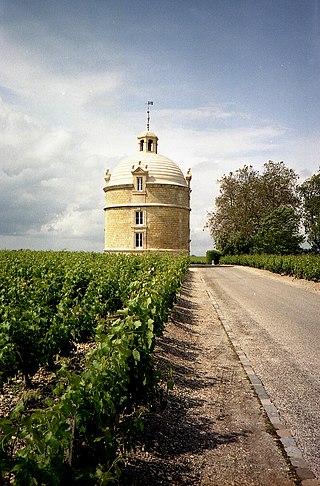
Château Latour is a French wine estate, rated as a First Growth under the 1855 Bordeaux Classification. Latour lies at the very southeastern tip of the commune of Pauillac in the Médoc region to the north-west of Bordeaux, at its border with Saint-Julien, and only a few hundred metres from the banks of the Gironde estuary.

Bordeaux wine is produced in the Bordeaux region of southwest France, around the city of Bordeaux, on the Garonne River. To the north of the city, the Dordogne River joins the Garonne forming the broad estuary called the Gironde; the Gironde department, with a total vineyard area of 110,800 hectares, is the second largest wine-growing area in France behind the Languedoc-Rousillon.

French wine is produced all throughout France, in quantities between 50 and 60 million hectolitres per year, or 7–8 billion bottles. France is one of the largest wine producers in the world, along with Italian, Spanish, and American wine-producing regions. French wine traces its history to the 6th century BCE, with many of France's regions dating their wine-making history to Roman times. The wines produced range from expensive wines sold internationally to modest wines usually only seen within France such as the Margnat wines of the post-war period.
Château Lascombes is a winery in the Margaux appellation of the Bordeaux region of France. The wine produced here was classified as one of fifteen Seconds Crus in the original Bordeaux Wine Official Classification of 1855. In the 1950s, the estate was purchased by French wine writer Alexis Lichine who continued to own part of the estate till 1971 when Bass Charrington took over principal ownership. In 2001 it was purchased by Yves Vatelot and US-based Colony Capital, who in 2011 sold it to the French insurance group MACSF. In addition to its premier cuvee, a second wine is also produced, under the name Chevalier de Lascombes. Additional brands are Château Segonnes, Rosé de Lascombes, Vin Sec Chevalier de Lascombes and Gombaud.
The glossary of wine terms lists the definitions of many general terms used within the wine industry. For terms specific to viticulture, winemaking, grape varieties, and wine tasting, see the topic specific list in the "See also" section below.
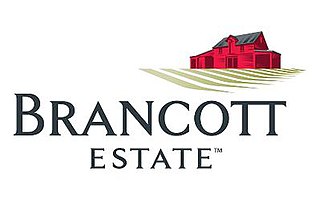
Brancott Estate is the brand adopted since 2010 by Pernod Ricard for New Zealand's largest wine producer, formerly Montana Wines, which now operates as the New Zealand division of Pernod Ricard Winemakers. The name comes from its Brancott winery in Blenheim, and was chosen to reduce confusion in the United States market with wines from the state of Montana.

Château Cantemerle is a winery in the Haut-Médoc appellation of the Bordeaux wine region of France, in the commune of Macau. The wine produced here was the final estate to be classified as one of eighteen Cinquièmes Crus in the Bordeaux Wine Official Classification of 1855. Its absence from the classification map featured at the 1855 Exposition Universelle de Paris created some controversy, even though it has been listed on all maps published after 1855. Some sources will include an asterisk next to Château Cantemerle listing in reference to this controversy. The estate has a long history in the Haut-Médoc with records detailing its existence since at least the 12th century and wine production since at least the 14th century. In the 19th century, the estate was hard hit by the phylloxera epidemic as well as grapevine attacks of downy mildew, after which production dropped nearly 50%. Towards the end of the 20th century, the estate was sold to French insurance group Les Mutuelles d'Assurance du Bâtiment et des Travaux Public who have contributed significant investment in the estate's vineyards and winemaking facilities.
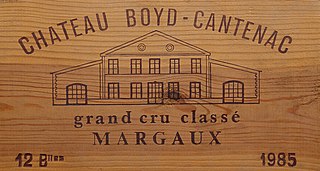
Château Boyd-Cantenac is a winery in the Margaux appellation of the Bordeaux region of France. The wine produced here was classified as one of fourteen Troisièmes Crus in the historic Bordeaux Wine Official Classification of 1855. The vineyard, totalling 46 acres (190,000 m2), is planted with Cabernet Sauvignon, Merlot, Cabernet Franc, and Petit Verdot and abuts other Margaux châteaux, including Château Brane-Cantenac and Château Kirwan. Producing annually 5,000-6,000 cases, Boyd Cantenac makes in addition to its Grand vin, a second wine under the labels Jacques Boyd and Josephine de Boyd.
Château Desmirail is a winery in the Margaux appellation of the Bordeaux wine region of France. It was classified as one of fourteen Troisièmes Crus in the historic Bordeaux Wine Official Classification of 1855.
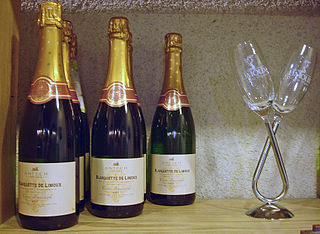
Limoux wine is produced around the city of Limoux in Languedoc in southwestern France. Limoux wine is produced under four Appellation d'origine contrôlée (AOC) designations: Blanquette de Limoux, Blanquette méthode ancestrale, Crémant de Limoux and Limoux, the first three of which are sparkling wines and dominate the production around Limoux. The main grape of the region is the Mauzac, locally known as Blanquette, followed by Chardonnay and Chenin blanc. In 2005, the Limoux AOC was created to include red wine production consisting of mostly Merlot. Wine historians believe that the world's first sparkling wine was produced in this region in 1531, by the monks at the abbey in Saint-Hilaire.
Château Les Ormes-de-Pez, or Château Ormes de Pez, is a winery in the Saint-Estèphe appellation of the Bordeaux wine region of France, near the hamlet of Pez. The wine produced here was classified as one of 9 Cru Bourgeois Exceptionnels in the 2003 listing. Though this classification is currently annulled, it is expected to be revived by the 2009 vintage, but without use of the quality divisions such as "exceptionnel".

The wine regions of Bordeaux in France are a large number of wine growing areas, differing widely in size and sometimes overlapping, which lie within the overarching wine region of Bordeaux, centred on the city of Bordeaux and covering the whole area of the Gironde department of Aquitaine.

Mas de Daumas Gassac is a French wine producer from the wine region Languedoc, classified as Vin de Pays de l'Hérault due to its use of grape varieties outside specifications of its AOC. The winery, producing both white and red wine, is located in the south of France, in the commune of Aniane. Despite its modest designation and location, the vineyard has received widespread acknowledgement, described by The Times to taste like a "Latour" and by the French gastronomic guide GaultMillau as the "Lafite Rothschild of the Languedoc-Roussillon", it is frequently referred to as the Grand cru of the Languedoc.
Château Couhins is a Bordeaux wine estate from the Pessac-Léognan appellation, ranked among the GrandsCrus Classés for dry white wine in the Classification of Graves wine of 1959. The winery is located in close Southern vicinity of the city of Bordeaux, in the commune of Villenave-d'Ornon.

Château Bouscaut is a Bordeaux wine from the Pessac-Léognan appellation, ranked among the Crus Classés for red and dry white wine in the Classification of Graves wine of 1953 and 1959. The winery and vineyards are located south of the city of Bordeaux, in the commune of Cadaujac.
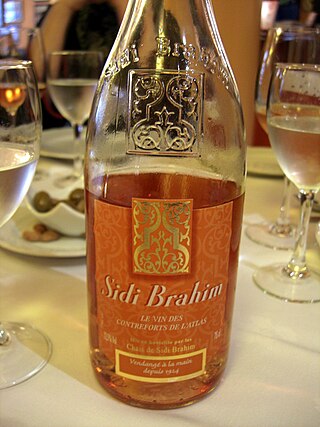
Sidi Brahim is a range of branded wines produced in the Atlas Mountains, first in Algeria, then in Morocco and now in Tunisia. The wines are blended and bottled or filled into bag-in-boxes in France, and are primarily sold there. It was the second-best selling foreign wine in France, behind Boulaouane, as of 2005. The production volume is around three million bottles annually. The wine has been named after the Battle of Sidi-Brahim (1845).
Château Tournefeuille is a wine estate in Lalande-de-Pomerol, an appellation in Bordeaux near Pomerol and St. Emilion.

Saint-Estèphe is an Appellation d'Origine Contrôlée (AOC) for red wine in the Bordeaux region, located in the Médoc subregion. It takes its name from the commune of Saint-Estèphe and is the northernmost of the six communal appellations in Médoc. Five classified growths of 1855 are located within the appellation area. Saint-Estèphe has held AOC recognition since 1936.
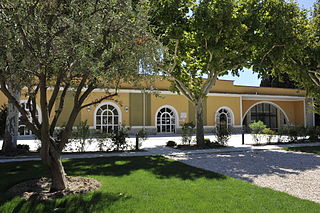
Les Vins Skalli is a French wine company based in Châteauneuf-du-Pape. The company produces French varietal wines, and in the 1980's, the company widened its focus to include wines from the Languedoc region, the Rhone Valley region, Provence, and Napa Valley.













